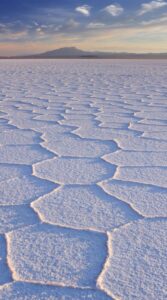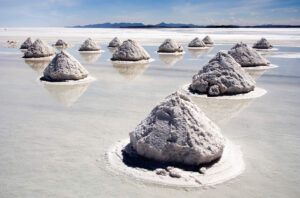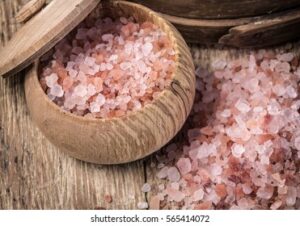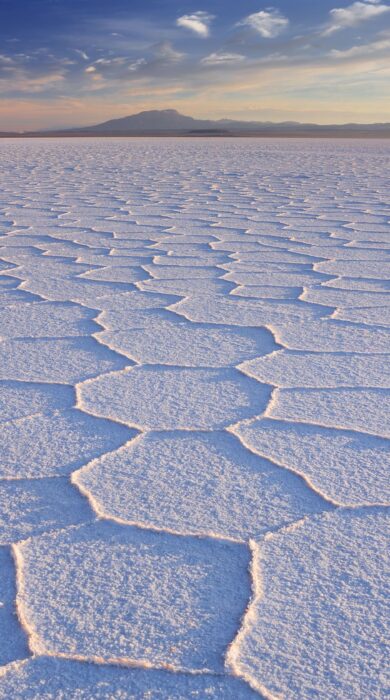



Salt and Sodium
Role of salt in our body
Description
Salt, also known as sodium chloride, is about 40% sodium and 60% chloride. It flavors food and is used as a binder and stabilizer. It is also a food preservative, as bacteria can’t thrive in the presence of a high amount of salt. The human body requires a small amount of sodium to conduct nerve impulses, contract and relax muscles, and maintain the proper balance of water and minerals. It is estimated that we need about 500 mg of sodium daily for these vital functions. But too much sodium in the diet can lead to high blood pressure, heart disease, and stroke. It can also cause calcium losses.
Introduction
Salt, a common ingredient found in kitchens worldwide, has long been under scrutiny for its potential impact on health, but does salt raise blood pressure? While it’s a crucial component for various bodily functions, most Americans consume too much salt, which is linked to an increased risk of high blood pressure, heart disease and stroke.
The Role of Salt in the Body
Salt plays a crucial role in the body. It helps with fluid balance, nerve transmission, and muscle function. However, it’s the balance of salt intake that is key to maintaining health.
How Salt Affects Blood Pressure
Osmotic Balance and Fluid Retention
Salt can affect blood pressure through its role in osmotic balance. When you consume salt, it increases the amount of sodium in your bloodstream, disrupting the balance between sodium and water. To restore this balance, the body retains water, increasing the volume of blood, which in turn raises blood pressure.
Impact on the Kidneys
The kidneys play a vital role in controlling blood pressure by regulating the amount of fluid stored in the body. Excessive salt intake can make this regulation more challenging, potentially leading to higher blood pressure.
Research on Salt and Hypertension
Numerous studies have shown a correlation between high salt intake and hypertension (high blood pressure). For instance, populations with lower salt consumption tend to have healthier average blood pressure levels and reduced incidences of hypertension.
Recommended Salt Intake
The American Heart Association recommends no more than 2,300 milligrams (mg) a day and moving toward an ideal limit of no more than 1,500 mg per day for most adults. This is particularly important for individuals with hypertension or prehypertension.
Reducing Salt Intake
Reducing salt intake can be challenging, given its prevalence in processed and restaurant foods. Here are some tips:
- Read labels to check for sodium content.
- Cook at home more often, using fresh ingredients.
- Limit processed foods, which are often high in sodium.
- Use herbs and spices instead of salt to flavor your food.
Individual Variability
It’s important to note that individuals vary in their sensitivity to salt. Some people may be more prone to the effects of salt on blood pressure than others. This is why personalized medical advice is crucial.
Your Health Matters
At The Kidney and Hypertension Center, we understand the importance of personalized care in managing blood pressure and overall kidney health. If you have concerns about hypertension or your diet, our team of experts is here to help. Schedule an appointment today for tailored advice and treatment options. Remember, managing your salt intake is just one part of maintaining a healthy blood pressure and a healthy life.
For comprehensive and personalized care, contact The Kidney and Hypertension Center
In brief salt role
some of which may be pulled from bone. Most Americans consume at least 1.5 teaspoons of salt per day, or about 3400 mg of sodium, which contains far more than our bodies need. Recommended Amounts The U.S. Dietary Reference Intakes state that there is not enough evidence to establish a Recommended Dietary Allowance or a toxic level for sodium (aside from chronic disease risk). Because of this, a Tolerable Upper intake Level (UL) has not been established; a UL is the maximum daily intake unlikely to cause harmful effects on health.
Guidelines for Adequate Intakes (AI) of sodium were established based on the lowest levels of sodium intake used in randomized controlled trials that did not show a deficiency but that also allowed for an adequate intake of nutritious foods naturally containing sodium. For men and women 14 years of age and older and pregnant women, the AI is 1,500 milligrams a day. A Chronic Disease Risk Reduction (CDRR) Intake has also been established, based on the evidence of benefit of a reduced sodium intake on the risk of cardiovascular disease and high blood pressure.
Reducing sodium intakes below the CDRR is expected to lower the risk of chronic disease in the general healthy population. The CDRR lists 2,300 milligrams a day as the maximum amount to consume for chronic disease reduction for men and women 14 years of age and older and pregnant women. Most people in the U.S. consume more sodium than the AI or CDRR guidelines. [1] Types of Salt Finely ground salts are dense, so they tend to contain more sodium than coarser salts. Note that sodium content can vary widely among brands, so check the Nutrition Facts label for exact amounts.
Food Sources Sodium isn’t generally a nutrient that you need to look for; it finds you. Almost any unprocessed food like fruits, vegetables, whole grains, nuts, meats, and dairy foods is low in sodium. Most of the salt in our diets comes from commercially prepared foods, not from salt added to cooking at home or even from salt added at the table before eating. [1,18] According to The Centers for Disease Control and Prevention, the top 10 sources of sodium in our diets include: breads/rolls; pizza; sandwiches; cold cuts/cured meats; soups; burritos, tacos; savory snacks (chips, popcorn, pretzels, crackers); chicken; cheese; eggs, omelets.
Your body needs salt to function properly. Consuming too much or too little can lead to medical problems. To avoid this, check food labels to make sure you’re not consuming too much and eat a balanced diet
Signs of Deficiency and Toxicity Deficiency A deficiency of sodium in the U.S. is rare because it is so commonly added to a wide variety of foods and occurs naturally in some foods. Hyponatremia is the term used to describe abnormally low amounts of sodium in the blood. This occurs mainly in older adults, particularly those living in long-term care facilities or hospitals who take medications or have health conditions that deplete the body of sodium, leading to hyponatremia.
Excess vomiting, diarrhea, and sweating can also cause hyponatremia if salt is lost in these fluids that are expelled from the body. Sometimes too much fluid abnormally collecting in the body can lead to hyponatremia, which might stem from diseases such as heart failure or liver cirrhosis. In rare cases, simply drinking too much fluid can lead to hyponatremia if the kidneys can’t excrete the excess water. Symptoms of hyponatremia can include: nausea, vomiting, headaches, altered mental state/confusion, lethargy, seizures, coma.
Toxicity Too much sodium in the blood is called hypernatremia. This acute condition can happen in older adults who are mentally and physically impaired who do not eat or drink enough, or who are sick with a high fever, vomiting, or infection that causes severe dehydration. Excessive sweating or diuretic medications that deplete the body of water are other causes. When sodium accumulates in the blood, water is transferred out of cells and into the blood to dilute it. This fluid shift and a build-up of fluid in the brain can cause seizures, coma, or even death. Extra fluid collecting in the lungs can cause difficulty breathing.
Other symptoms of hypernatremia can include: nausea, vomiting, weakness, loss of appetite, intense thirst, confusion, kidney damage .
Health organizations have been on alert about the dangers of salt for a long time.
There are claims that excess salt intake causes high blood pressure and heart disease. Yet, decades of research have observed conflicting results.
What’s more, some evidence shows that eating too little salt can be harmful.
This article takes a detailed look at salt and whether it’s healthy.
Salt is the most significant source of sodium in your diet. Also known as sodium chloride (NaCl), it comprises 40% sodium and 60% chloride. Today, the terms “salt” and “sodium” are often used interchangeably
Some salt varieties are fortified with iodine, iron, folic acid, or a combination of these. For example, table salt often contains.
Sodium is essential for many essential body functions, including fluid balance, nerve health, nutrient absorption, and muscle function.
Salt is typically harvested from salt mines or by evaporating seawater or other mineral-rich water.
Side effects of too much salt
While your body needs some salt to function properly, too much of it can be detrimental to your health.
Are “natural” salts healthier than table salt? Salt is harvested from salt mines or by evaporating ocean water. All types of salt are made of sodium chloride, and the nutrient content varies minimally. Although less processed salts contain small amounts of minerals, the amount is not enough to offer substantial nutritional benefit. Different salts are chosen mainly for flavor.
The most widely used, table salt, is extracted from underground salt deposits. It is heavily processed to remove impurities, which may also remove trace minerals. It is then ground very fine. Iodine, a trace mineral, was added to salt in 1924 to prevent goiter and hypothyroidism, medical conditions caused by iodine deficiency. Table salt also often contains an anticaking agent such as calcium silicate to prevent clumps from forming.
Kosher salt is a coarsely grained salt named for its use in traditional Kosher food preparation. Kosher salt does not typically contain iodine but may have an anti-caking agent. Sea salt is produced by evaporating ocean or sea water. It is also composed mostly of sodium chloride, but sometimes contains small amounts of minerals like potassium, zinc, and iron depending on where it was harvested. Because it is not highly refined and ground like table salt, it may appear coarser and darker with an uneven color, indicating the remaining impurities and nutrients.
Unfortunately, some of these impurities can contain metals found in the ocean, like lead. The coarseness and granule size will vary by brand.
Himalayan pink salt is harvested from mines in Pakistan. Its pink hue comes from small amounts of iron oxide. Similar to sea salt, it is less processed and refined and therefore the crystals appear larger and contain small amounts of minerals including iron, calcium, potassium, and magnesium. Larger, coarser salt granules do not dissolve as easily or evenly in cooking, but offer a burst of flavor. They are best used sprinkled onto meats and vegetables before cooking or immediately after. They should not be used in baking recipes. Keep in mind that measurements of different salts are not always interchangeable in recipes.
Generally, sea salt and table salt can be interchanged if the granule size is similar. However, table salt tends to have more concentrated, saltier flavor than kosher salt, so the substitution is one teaspoon of table salt for about 1.5 to 2 teaspoons of kosher salt depending on the brand
Salt side effectsor harm
Excess sodium intake is a global concern. For example, it’s a risk factor for hypertension, also known as high blood pressure. Hypertension increases your risk of heart failure, a condition in which your heart can’t properly pump blood throughout your body
Salt affects blood pressure via several complex pathways that affect your body’s hormonal, inflammatory, immune, and digestive systems. Overeating salt may also suppress the renin-angiotensin system, which regulates blood pressure and sodium levels
Fortunately, reducing your salt intake might lower your blood pressure level, especially in people with a medical condition called salt-sensitive hypertension
In a 2016 analysis of 4 large studies including 113,118 people with and without hypertension, the risk of heart disease and death was higher in those who had a high sodium intake, compared with those with a moderate sodium intake
Similarly, a review of research in 229,785 adults who were followed for 13 years found that higher intakes of sodium were associated with death from heart disease
There are also doubts about how beneficial it is to restrict sodium, with some studies suggesting that a moderate sodium intake of around 1–2 teaspoons daily isn’t linked to an increased heart disease risk
Interestingly, it also remains unknown whether reducing your salt intake has any blood pressure benefits if you don’t have hypertension.
A 2014 review found that reducing daily dietary sodium by 2.3 grams decreased systolic blood pressure by an average of only 3.82 mmHg — both among people with and without hypertension.
Systolic blood pressure is the top number of blood pressure readings. It signals the pressure your blood applies to artery walls with each heartbeat. Worldwide, mean readings sit around 125–144 mmHg, making the importance of a 3.82 mmHg reduction questionable.
What’s more, a recent review found that when reducing sodium intake, people with hypertension experienced a steeper decline in blood pressure than people without hypertension.
Possibly linked to stomach cancer
Stomach cancer, also known as gastric cancer, is one of the most common types of cancer and the fourth leading cause of cancer death worldwide
Several studies associate high salt diets, typically including foods like salted meats and pickled vegetables, with an increased risk of stomach cancer.
A 2016 study in 40,729 Japanese adults found that those with stronger preferences for salty foods had a 30% greater risk of developing gastric cancer than people who preferred less salty foods.
The reasons why salt may promote gastric cancer are not well understood.
It’s speculated that high salt intakes may increase the growth of
(H. pylori) in your stomach. H. This type of bacteria can lead to inflammation, gastric ulcers, and possibly the development of gastric cancer
Through continued research is needed, some research postulates that a high salt diet may increase cell mutations and cell multiplication, which are characteristics of cancer development
Still, keep in mind that these studies don’t prove that a high salt intake causes stomach cancer, only that the two might be strongly associated. In the end, more research on the topic is warranted.
Role of salt in bread making
There are only four essential ingredients in basic breadmaking: flour, water, yeast, and salt. The role of the first three ingredients is clear – flour and water to form the dough, and yeast to make it rise.
But what about salt? What is the role of salt in breadmaking? Is it really essential?
Salt, as it turns out, plays not just one but multiple roles in making bread. It fulfils several objectives, both organoleptic and technical. Indeed, salt is necessary for baking a successful loaf with great taste, texture and appearance.
What does salt do in bread?
In breadmaking, salt is a taste enhancer as well as a functional ingredient. It has four important functions as follow:
1. Strengthens gluten network
Salt is necessary for the proper formation of gluten. It tightens the gluten strands to make them stronger so that the dough can hold carbon dioxide more efficiently, resulting in a strong and elastic dough.
2. Controls yeast activity
Salt slows down the growth and reproduction of yeast in the bread dough. A reduction in salt will increase yeast activity, resulting in a less stable dough that will impact the first rise and final proofing stages. The tolerance of dough will also then be reduced.
3. Enhances flavour
Salt absorbs moisture and flavours to enhance the taste and aroma of breads. Without salt, bread tastes bland and less aromatic – with just a dominant ‘wheat’ flavour from the flour. Basically, bread is not very appetizing and rather lifeless without salt.
4. Improves crust colour
Salt determines the brownness of the crust colour by curtailing yeast to consume all the residual sugar in the dough. This sugar gives bread the deep golden-brown crust as it caramelizes during baking.
How much salt to use in bread?
The level of salt to use in bread is largely determined by the flavour that is desired in the
end product. The range of use can vary from 2% in European style breads to 0.5% or lower in some flatbreads.
The percentage of use is also dependent on the region and countries, and often reflects how the bread is eaten. For example, less salty bread is usually paired with very salty or spicy food.
Is it possible to add too much salt to bread?
An excess of salt will result in poor volume, slow fermentation due to the detrimental effect on the yeast, an unpleasant flavour, and a reddish-brown crust colour also known as a ‘foxy’ crust.
Our Baking Center™support
History of salt
A timeless ingredient
As far back as 6050 BC, salt has been an important and integral part of the world’s history, as it has been interwoven into countless civilizations. Used as a part of Egyptian religious offerings and valuable trade between the Phoenicians and their Mediterranean empire, salt and history have been inextricably intertwined for millennia, with great importance placed on salt by many different cultures. Even today, the history of salt touches our daily lives. The word “salary” was derived from the word “salt.” Salt was highly valued and its production was legally restricted in ancient times, so it was historically used as a method of trade and currency. The word “salad” also originated from “salt,” and began with the early Romans salting their leafy greens and vegetables. Undeniably, the history of salt is both broad and unique, leaving its indelible mark in cultures across the globe.
Most people probably think of salt as simply that white granular seasoning found in saltshakers on virtually every dining table.
It is that, surely, but it is far more. It is an essential element in the diet of not only humans but of animals, and even of many plants. It is one of the most effective and most widely used of all food preservatives. Its industrial and other uses are almost without number. Salt has great current interest as the subject of humorous cartoons, poetry and filmmaking.
The fact is that throughout history, salt—called sodium chloride by chemists—has been such an important element of life that it has been the subject of many stories, fables, folktales and fairy tales. It served as money at various times and places, and it has been the cause of bitter warfare. Offering bread and salt to visitors, in many cultures, is traditional etiquette. While records show the importance of salt in commerce in medieval times and earlier, in some places like the Sahara and in Nepal, salt trading today gives a glimpse of what life may have been like centuries ago.
Salt was in general use long before the beginning of recorded history, and dating back to around 2700 B.C. the earliest known treatise on pharmacology was published in China. A major portion of this writing is devoted to a discussion of more than 40 kinds of salt, including descriptions of two methods of salt extraction that are similar to processes used today. Salt production has been important in China for two millennia or more, and the Chinese, like many other governments over time, realized that taxing salt would could be a major revenue source. Nomads spreading westward were known to carry salt, and Egyptian art from as long ago as 1450 B.C. records salt making.
Salt was of crucial importance economically. The expression ânot worth his saltâ stems from the practice of trading slaves for salt in ancient Greece. Special salt rations given to early Roman soldiers were known as “salarium argentum,” the forerunner of the English word “salary.” References to salt can be found in languages around the globe, particularly regarding salt used for food. From the Latin “sal,” for example, come such other derived words as “sauce” and “sausage.” Salt was an important trading commodity carried by explorers.
Salt has played a vital part in religious ritual in many cultures, symbolizing purity. There are more than 30 references to salt in the Bible, including the well-known expression “salt of the earth.” Additionally, there are many other literary and religious references to salt, including use of salt on altars representing purity, and use of “holy salt” by the Unification Church.
Salt making encompasses much of the history of the United Kingdom, particularly in the Cheshire area. Medieval European records document salt making concessions. In continental Europe, Venice rose to economic greatness through its salt monopoly. Salt making was important in the Adriatic/Balkans region as well (the present border between Slovenia and Croatia); in Bosnia-Herzegovina, Tuzla is actually named for “tuz,” the Turkish word for salt. The same is true for Salzburg, Austria, which has made its four salt mines major tourist attractions. Similarly in Bolivia, the main salt producing region is a tourist attraction and includes one hotel constructed entirely of salt. The grand designs of Philip II of Spain came undone through the Dutch Revolt at the end of the 16thCentury; one of the keys, according to Montesquieu, was the successful Dutch blockade of Iberian salt works, which led directly to Spanish bankruptcy. Salt making was (and still is) important in Holland, as well. France has always been a major producer of salt and any discussion of salt making and distribution in France includes discussion of the gabelle, the salt tax that was a significant contributor to the French Revolution. The salt remains just as important today. The magnitude of the gabelle is astounding; from 1630 to 1710, the tax increased from 14 times the cost of production to 140 times the cost of production, according to Pierre Laszlo in his book Salt: Grain of Life (Columbia Univ. Press). You may be familiar with the phrase: “Siberian salt mines,” although salt making takes place in many places across Russia. In the Middle East, the Jordanian town of As-Salt, located on the road between Amman and Jerusalem, was known as Saltus in Byzantine times and was the seat of a bishopric. Later destroyed by the Mongols, it was rebuilt by the Mamluke sultan Baybars I in the 13th century; the ruins of his fortress remain today. Indian history recalls the prominent role of salt (including the Great Hedge and its role in the British salt starvation policy) and Mahatma Gandhi’s resistance to British colonial rule. Additionally, salt played a key role in the history of West Africa.
Salt has played a prominent role in the European exploration of North America and subsequent American history, Canadian history, and Mexican history, as well. The first Native Americans “discovered” by Europeans in the Caribbean were harvesting sea salt on St. Maarten. When the major European fishing fleets discovered the Grand Banks of Newfoundland at the end of the 15th century, the Portuguese and Spanish fleets used the “wet” method of salting their fish onboard, while the French and English fleets used the “dry” or “shore” salting method of drying their catch on racks onshore. Due to this early food processing, French and British fishermen became the first European inhabitants of North America since the Vikings a half-century earlier. Had it not been for the practice of salting fish, Europeans might have confined their fishing to the coasts of Europe and delayed “discovery” of the New World.
Salt motivated the American pioneers. The American Revolution had heroes who were salt makers and part of the British strategy was to deny the American rebels access to salt. Salt was on the mind of William Clark in the groundbreaking Lewis and Clark expedition to the Pacific Northwest. The first patent issued by the British crown to an American settler gave Samuel Winslow of the Massachusetts Bay Colony the exclusive right for ten years to make salt by his particular method. The Land Act of 1795 included a provision for salt reservations (to prevent monopolies), as did an earlier treaty between the Iroquois’ Onondaga tribe and the state of New York. New York has always been important in salt production. The famed Erie Canal, opened in 1825, was known as “the ditch that salt built” because salt, a bulky product presenting major transportation difficulties, was its principal cargo. Syracuse, NY, is proud of its salt history and its nickname, “Salt City.” Salt production has been important in Michigan and West Virginia for more than a century. Salt played an important role on the U.S. frontier, including areas like Illinois and Nebraska, although they no longer have commercial salt production.
Salt played a key role in the Civil War, as well. In 1864, Union forces made a forced march and fought a 36-hour battle to capture Saltville, Virginia, the site of an important salt processing plant thought essential to sustaining the South’s beleaguered armies. Civilian distress over the lack of salt in the wartime Confederacy undermined rebel morale, too. The important role of salt in the history of Kansas is captured in a salt museum in Hutchinson, KS. The vast distances in the American West sometimes required passage over extensive salt flats. In Canada, Windsor Salt is more than a century old. In the American West, a “salt war” was fought at El Paso, TX and we know that Nevada was known as more than a silver state. Many cities, counties, land features and other landmarks reflect the importance of salt. Salt, of course, has many uses; some techniques using salt such as production of “salt prints” in 19th Century photography have been superseded by new technologies, but others have not. However, not all American “salt history” is so old. Salt-glazed pottery is still popular. Salt is even associated with the struggle for women’s rights in the U.S.
Salt also had military significance. For instance, it is recorded that thousands of Napoleon’s troops died during his retreat from Moscow because their wounds would not heal due to the lack of salt. In 1777, the British Lord Howe was jubilant when he succeeded in capturing General Washington’s salt supply.
Similarly throughout history, salt has been subjected to governmental monopoly and special taxes. French kings developed a salt monopoly by selling exclusive rights to produce it to a favored few who exploited that right to the point that the scarcity of salt contributed to the French Revolution. Salt taxes long supported British monarchs and thousands of British people were imprisoned for smuggling salt. In modern times, Mahatma Gandhi defied British salt laws as a means of mobilizing popular support for self-rule in India. In recent years, the promotion of free trade through the World .
